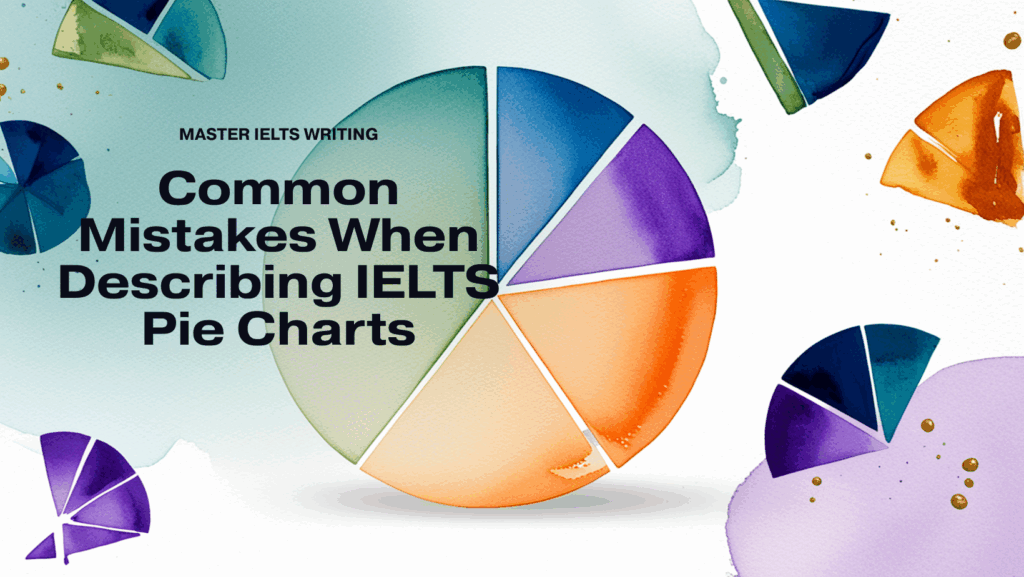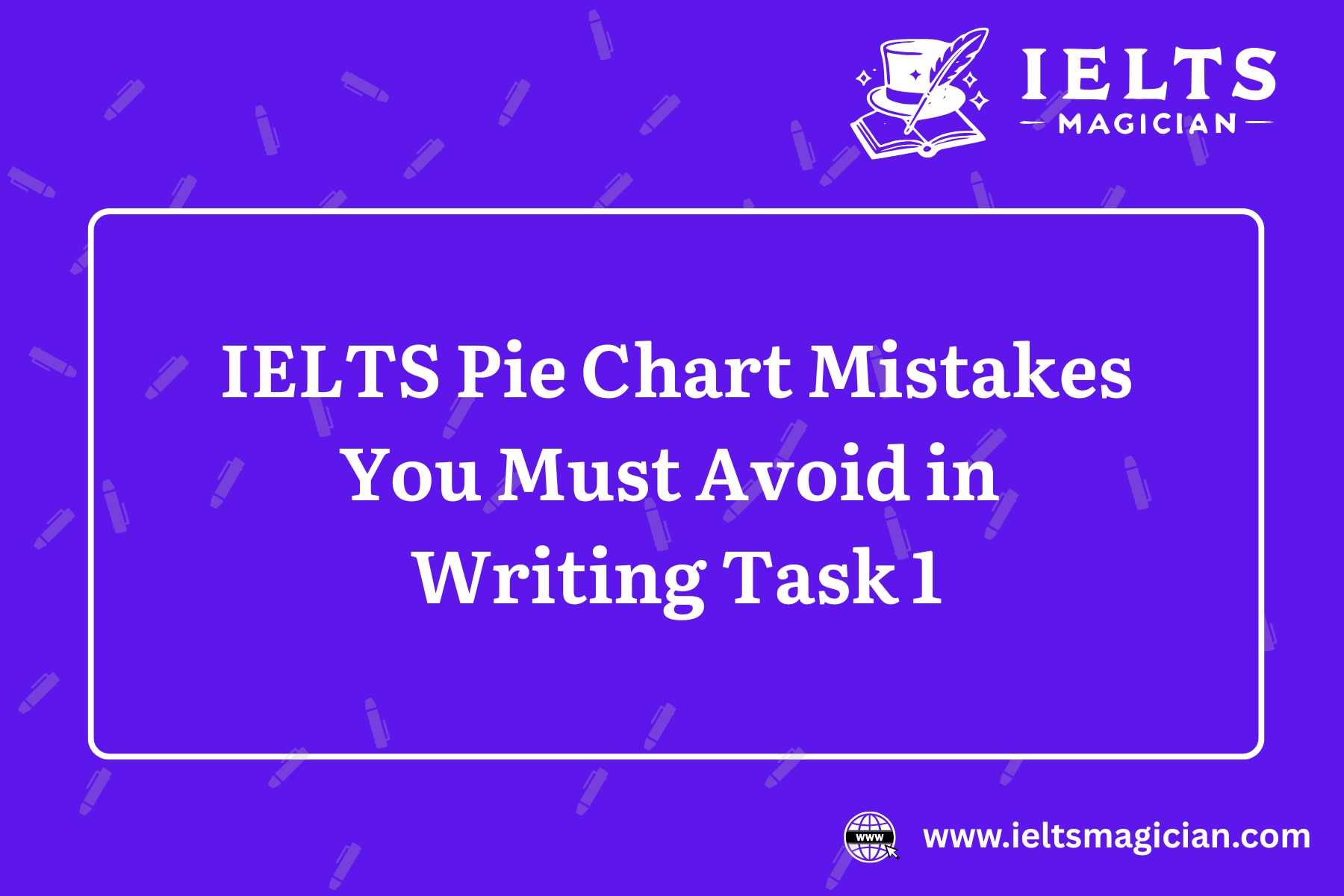Introduction
IELTS pie charts appear in Writing Task 1 to test your ability to describe, analyze, and compare statistical data.
Candidates must present percentage distributions in a clear, logical, and structured way to meet examiner band score criteria.
A strong report identifies key trends, highlights major and minor categories, and uses accurate vocabulary for describing proportional data.
This guide explains how to interpret pie chart information, organize your response, and avoid common mistakes that lower scores.
What is an IELTS Pie Chart in Writing Task 1?
An IELTS pie chart is a visual representation showing the percentage distribution of categories in a dataset. In the exam, candidates describe pie chart data to demonstrate analytical and descriptive writing skills. The chart often appears alone or with another graph or table.
- Purpose in IELTS: Test ability to analyze, compare, and summarize statistics.
- Common Data Types: Population breakdowns, spending patterns, resource usage, survey results.
How Do IELTS Tasks Use Pie Chart Data?
In IELTS Writing Task 1, the task requirements specify that you must:
- Interpret the chart and identify key trends.
- Compare categories using accurate percentage terms.
- Summarize the main features without personal opinion.
Example:
A pie chart showing energy consumption by sector in 1990 and 2020 tests your ability to compare changes over time.
How to Describe a Pie Chart in IELTS Writing Task 1
To describe a pie chart effectively, follow a logical structure:
- Introduction – Paraphrase the task prompt.
- Overview – Summarize key trends and largest/smallest proportions.
- Detailed Analysis – Group related data and highlight differences.
- Comparison – Use comparative language for percentages.
| Section | Purpose | Example Sentence |
| Introduction | Present topic without copying task words | “The chart illustrates…” |
| Overview | Summarize trends | “The majority of spending was on…” |
| Details | Provide exact data | “Education accounted for 25%…” |
| Comparison | Show differences or similarities | “This was double the share of…” |
What Vocabulary is Best for IELTS Pie Chart Descriptions?
Strong vocabulary improves your band score in the lexical resource criterion. Use varied verbs, adjectives, and nouns from the examiner’s criteria list.
Useful Verbs:
- describe, analyze, compare, interpret, summarize, present, illustrate, represent, depict, highlight, explain
Useful Adjectives:
- accurate, clear, concise, descriptive, informative, logical, structured, analytical, objective
Example sentence:
“The chart illustrates the percentage of renewable energy sources, highlighting the dominance of solar power.”
How to Compare Percentages Effectively in IELTS
Comparisons show examiner that you can analyze data:
- Higher proportion: “X accounted for a larger share than Y.”
- Double / triple: “X was twice the size of Y.”
- Fractional differences: “X made up one-third of the total, compared to one-quarter for Y.”
Tip: Avoid exact repetition; vary phrasing like “made up,” “represented,” “accounted for”.
What Band Descriptors Apply to IELTS Pie Chart Descriptions?
IELTS examiners assess pie chart tasks on four criteria:
- Task Achievement – Accurate description of trends.
- Coherence and Cohesion – Logical and organized structure.
- Lexical Resource – Rich, topic-specific vocabulary.
- Grammatical Range and Accuracy – Correct sentence structures.
Band 7+ Candidate Example:
Writes an overview summarizing the largest and smallest categories, compares percentages logically, and uses a variety of comparative structures.
Common Mistakes When Describing IELTS Pie Charts
- Listing every figure without grouping data.
- Failing to write an overview.
- Using incorrect percentage comparisons.
- Repeating the same vocabulary.
- Including personal opinions in Task 1.

Correct Approach: Group similar categories, present data logically, and maintain objective tone.
Time Management for IELTS Pie Chart Tasks
- 20 minutes is recommended for Task 1.
- First 3 minutes: Analyze chart and plan structure.
- Next 15 minutes: Write introduction, overview, and details.
- Last 2 minutes: Check grammar and vocabulary.
Conclusion
Describing an IELTS pie chart well requires accurate data analysis, a concise overview, and organized comparison of categories.
Following the correct structure and using precise vocabulary helps meet the task requirements and improve your band score.
By practicing with varied charts and applying the strategies in this guide, candidates can present information clearly, coherently, and confidently in the exam.
FAQ: IELTS Pie Chart in Writing Task 1
1. How do you describe a pie chart in IELTS Writing Task 1?
Describe the main trends first, then present percentage data in a logical structure. Use comparative vocabulary, group related categories, and keep sentences clear, concise, and objective to meet examiner criteria for high scores.
2. What vocabulary is best for IELTS pie chart descriptions?
Use strong verbs like illustrate, depict, represent and adjectives like clear, analytical, objective. Vary percentage expressions (accounted for, made up, comprised) to improve lexical resource scores in the IELTS writing exam.
3. How do you compare percentages in an IELTS pie chart?
Compare using proportional terms (twice as much, half as large), rank order (largest share, smallest category), and differences in percentage points. Maintain accuracy and avoid exaggeration to meet band score requirements.
4. What is an overview in an IELTS pie chart report?
An overview summarizes the most significant trends and largest and smallest categories without detailed figures. It shows the examiner that you can identify key points, which is essential for Task Achievement scoring.
5. What common mistakes lower IELTS pie chart scores?
Mistakes include listing all figures without grouping, skipping the overview, repeating vocabulary, comparing incorrectly, and adding personal opinions. These errors reduce scores in coherence, task achievement, and lexical resource criteria.
6. How much time should I spend on an IELTS pie chart task?
Spend about 20 minutes. Use 3 minutes to plan, 15 minutes to write introduction, overview, and details, and 2 minutes for checking grammar, vocabulary, and structure to maximize IELTS band score.

